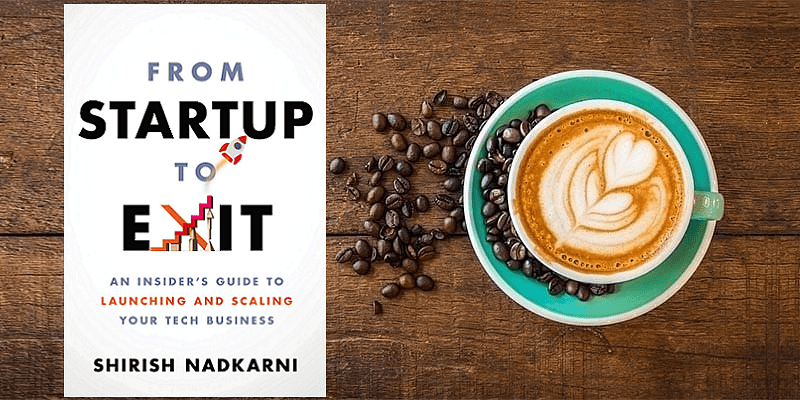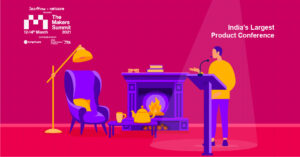Launched in 2012, YS’s Book Review section features over 325 titles on creativity, innovation, entrepreneurship, and digital transformation. See also our related columns The Turning Point, Techie Tuesdays, and Storybites.
Aspiring entrepreneurs will find a practical and informative roadmap for their journey in the book, From Startup to Exit: An Insider’s Guide to Launching and Scaling Your Tech Business by serial entrepreneur Shirish Nadkarni.
See also my reviews of the related books Startup Launchpad, Masters of Scale, Fail-safe Startup, Funding Your Startup, and Venture Capital Investments.
Shirish Nadkarni has over 20 years of experience in the tech startup space. His co-founded startups include Livemocha (social learning of languages; acquired by RosettaStone) and TeamOn Systems (mobile wireless e-mail solutions, acquired by RIM).
Here are my takeaways from this 300-page book, summarised as well in the table below. The material includes a glossary of terms and an appendix with an investor term sheet.
I. Ideation
A good idea solves a significant problem, and is an “aspirin, not a vitamin.” Examples include Slack, whose team-oriented communication platform tackles some of the problems of organisational email overload.
The idea should have network effects and even virality, Shirish adds. The term viral marketing was coined by Tim Draper. Hotmail had viral marketing embedded in sign-up invitation at the end of each message.
Network effects can be leveraged by competitors as well, and can be made irrelevant via new tech shifts (eg. Skype v/s WhatsApp). Incumbents like Blockbuster were disrupted by Netflix.
Microsoft’s Office strategy dislodged standalone competitors in word processing and spreadsheets. Blackberry had a good product-market fit – for a while, but was disrupted by other smartphone players.
Events like the pandemic have boosted sectors such as video collaboration, RPA, D2C, and home delivery.
Shirish advises founders to begin with a narrow customer segment before expansion. The first goal should be a “minimum delightful product” (rather than MVP). Getting to the MVP stage can take three months (B2C) or six months (B2B).
Mobile shopping app OfferUp first targeted women shoppers in Seattle before scaling up. DuoLingo launched on mobile devices, and leverage app payment to increase conversion rates to its premium offering.
The startup journey also calls for pivots, “It is not always easy for a founder or a founding team to admit defeat and pivot to a different idea,” Shirish cautions. They often fall in love with their first idea.
Facing traction challenges from the small business market, TeamOn had to pivot to a consumer mobile email model. Fortunately, this turned out to be something desirable and strategic for RIM, which acquired the startup instead of licensing its technology.
At the early stages, founders also need to assess whether they are really cut out to be an entrepreneur. As key qualities, Shirish lists reflection on capacity to take financial risks, ability to develop customer empathy, perseverance, and salesmanship.
II. Company formation
Legal entity classifications may vary across countries. In the US, Shirish describes startup options in the form of S Corporation, LLC, and C Corporation, with Delaware as base.
Founder equity should be split based on individual experiences and contributions (money, time). Founders can consult with angel investors or other successful founders on appropriate vesting schedules and ways to allot employee option pools.
Entrepreneurs should develop a sound understanding of the cap table in terms of shareholding, ownership, and share prices at different stages. Shirish recommends useful tools in this regard, such as Carta and Capshare.
III. Fundraising
Early stage funding can come from family and friends, followed by crowdfunding, angel investors, incubators, accelerators, and VCs.
Incubators may take a higher equity stake than accelerators, Shirish observes. Some of the top accelerators include Y Combinator, TechStars, and 500 Startups.
See YS’s Startup Hatch section with profiles of over 20 incubators and accelerators.
While raising angel funds, it helps to identify a lead investor who can line up other angel investors. After receiving a term sheet, it can take around a month to complete due diligence proceedings.
Storytelling is an important part of the founder’s pitch. It should cover industry trends as well as the founder’s personal journey and strengths (see YS’s Changemaker Story Canvas as a storytelling resource for founders).
In a startup, investors look at the team, traction, market size, and moat; tech VCs look for rapid growth as well. This should be conveyed in a crisp pitch deck, with an appendix of additional slides.
The pitch deck should cover purpose, problem, solution, traction, market opportunity, competition, go-to-market strategy, business model, team, financials, and the ask.
Shirish illustrates these principles through examples such as Airbnb, LinkedIn, Ally, and Poshmark. Ally offers SaaS solutions for managing OKRs, and used SEM and free trials for launch.
The fundraising journey is intense, and Shirish advises founders to become well-versed with terms like venture debt, convertible notes, liquidation preference, anti-dilution protection, and drag-along rights. Investors in successive rounds can have differing objectives and methods as well.
Venture debt can be a short-term bridge to the next round of financing, Shirish explains. Prominent US banks in this space include Silicon Valley Bank, Square 1 Bank, and Bridge Bank.
Founders need to learn how to work with boards, and understand the selection process and the rights of directors and observers. Shirish recommends that directors should have had prior entrepreneurship experience themselves (see also my review of the book Startup Boards).
IV. Running the company
A big chunk of the book focuses on execution issues, ranging from talent and culture to business model and IPR.
“The first four or five hires for your company are some of the most important. They set the tone for the culture of the company,” Shirish emphasises. They should have a growth mindset and be willing to do a range of tasks, with a blend of strategy and execution mindsets.
Interviewing them should involve diverse questions that determine culture fit. Founders should cross-check with the candidates’ specified references, and also go beyond them to get additional input.
“Firing people who are not a good fit for the company is an equally important skill,” Shirish adds. Otherwise, company morale and cohesiveness can be impacted.
Culture is reinforced through a long-term vision, value system, and constant communication. “Few founders spend time explicitly thinking about the culture that they want to establish in their company,” Shirish cautions.
As examples of culture gone off-track, he cites Uber’s earlier “win-at-all-costs bro culture,” and Microsoft’s earlier aggressive culture with Bill Gates’ yelling at employees.
As good examples of leadership principles, Shirish cites Amazon’s customer obsession, ownership, curiosity, bias for action, and results focus. The culture at contract management startup Icertis is captured in the acronym FORTE (fairness, openness, respect, teamwork, recognition).
Founders should also conduct due diligence on their investors and directors. Attending board meetings should not be seen as a chore or source of stress. Founders should prepare for the periodic meetings and extract value from them. Shirish recommends the Sequoia Capital board deck format as a good resource.
“Developing a robust business model is one of the most important tasks that you can perform for your company,” Shirish emphasises. Metrics like LTV and CAC should be clearly worked out. In the B2B sector, this involves building an effective sales force as well.
During downturns, it may be necessary to “make one deep cut” in team size rather than rolling layoffs, which may demoralise employees. “Employee layoffs are never easy and should be handled with care and dignity,” Shirish advises.
For example, Airbnb had to lay off 25 percent of its workforce during the pandemic, but offered job search assistance and extended healthcare coverage and severance pay. Shirish himself had to lay off employees from his earlier startup during the dotcom bust.
Customer and vendor contracts should be revisited, and renegotiated as necessary. Venture debt funding may need to be raised, which calls for solid VC backing.
In the pandemic era with WFH culture, Shirish urges founders to address the isolation that employees face, invest in ergonomic furniture, and promote random connections to keep alive the spirit of bonding, serendipity, and brainstorming.
V. Finding an exit
The material in this valuable section is not found in many other startup books. “The best time to sell your company is when the economy is booming and your company is experiencing strong growth year over year,” Shirish advises.
A list of potential acquirers should be built up in advance. But sometimes, investors may advise holding off for an IPO.
Hiring an investment bank helps shop around and get the best sale price, Shirish suggests. Founders should check out the experience of these banks, and check references as well.
“When I was at Microsoft, I led the acquisition of Hotmail, which we ended up acquiring for roughly $400 million,” Shirish recalls. Its user base and the timing fit into the growth plans for the MSN property.
Advantages of an IPO include liquidity, enhanced reputation, diversified investors, and growth capital. Challenges are increased scrutiny and vulnerability to hostile takeovers, Shirish explains.
IPO criteria include category leadership, growth potential, and line of sight to massive revenues in future. IPO preparation can be long and complex, and involves hiring a well-regarded CFO and a lead underwriter, as well as building a proper IPO team.
There should be clarity on market timing, size of the offering, and lockup period. IPO roadshows can be grueling, Shirish cautions.
Examples
Many of the principles in the book are illustrated in the concluding chapter’s profiles of five startups. For example, Icertis spotted an opportunity in contract management, and rode trends like regulatory compliance requirements, availability of ML and cloud, and millennials’ do-it-yourself mentality.
Founded in 2012, data warehousing startup Snowflake executed the largest software IPO in history, in September 2020.
Mobile-centric used goods marketplace OfferUp returned to its original vision after uninformed investors suggested a pivot. It later merged with competitor Letgo, and also raised funds from the OLX group.
Apptio, the “Quickbooks of IT spending” for small businesses, switched tack a few times before its IPO in 2016. It was eventually acquired by Vista Equity Partners, and could probably be sold later to a strategic player in the industry, according to Shirish.
RPA startup UIPath, founded by Romanian entrepreneur Daniel Dines, invested heavily in global sales and partnerships with consulting companies. It also expanded to India thanks to its large base of BPO firms, and offered on-premise as well as cloud solutions.
UIPath has a culture of openness and humility, and has established an anonymous feedback channel for anyone who wants to pinpoint issues. It had an IPO in April 2021.
In sum, this book offers founders a practical and insightful single-volume guide across the entire journey of a startup. The author’s personal anecdotes and experiences add to the credibility and authenticity of the narrative.
“The journey from ideation to founding to an exit is a long and arduous one that very few entrepreneurs successful make,” Shirish aptly describes.
YS has also published the pocketbook ‘Proverbs and Quotes for Entrepreneurs: A World of Inspiration for Startups’ as a creative and motivational guide for innovators (downloadable as apps here: Apple, Android).










